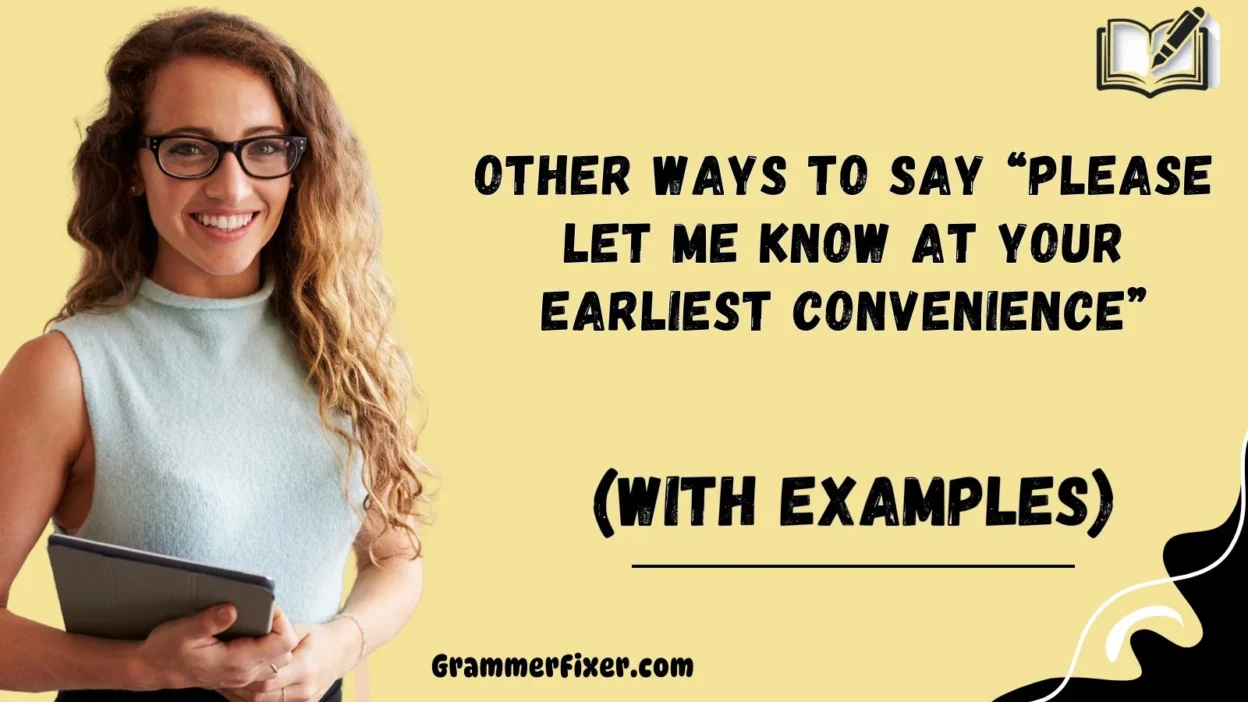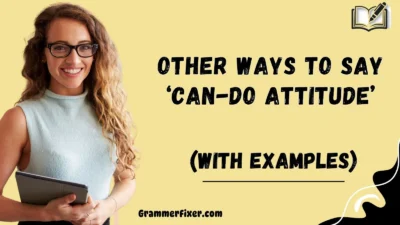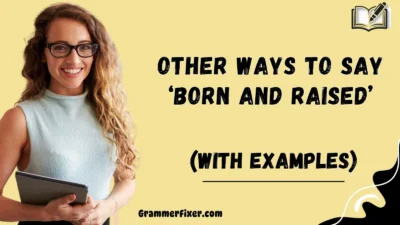Finding the right words when requesting a response can make all the difference. The phrase “Please let me know at your earliest convenience” is polite and professional, but sometimes it can feel a bit formal or repetitive. Choosing alternatives allows you to express warmth, care, and understanding, while still ensuring you get a timely response.
Below, we’ll explore 30 empathetic, thoughtful alternatives, with meanings, scenarios, and tones that help you communicate with sincerity and respect.
What Does “Please Let Me Know at Your Earliest Convenience” Mean?
The phrase simply means you are asking someone to respond or provide information when it is most suitable for them, without applying unnecessary pressure. It conveys politeness, patience, and respect for the recipient’s time.
When to Use “Please Let Me Know at Your Earliest Convenience”?
You can use this phrase in both formal and semi-formal communication, such as emails to colleagues, clients, or partners. It’s best used when you want to request information, updates, or confirmation without creating urgency.
Is It Professional/Polite to Say “Please Let Me Know at Your Earliest Convenience”?
Yes, it is widely considered professional, polite, and courteous. However, in some cases, it can sound too formal or impersonal. That’s why exploring alternative wordings can help you match the tone, context, and relationship with the recipient.
Pros or Cons of Using This Phrase
Pros
- Shows respect and politeness
- Keeps the tone professional
- Avoids sounding pushy
Cons
- Can sound overused or generic
- Might lack warmth and personal touch
- Sometimes interpreted as too vague
1. I Would Appreciate It If You Could Provide an Update
Meaning: A polite way of requesting information while showing gratitude.
Detailed Explanation: Adds warmth by expressing appreciation upfront.
Scenario Example: “I would appreciate it if you could provide an update on the project status by next week.”
Best Use: Formal emails to managers or clients.
Worst Use: Casual chats with close friends or text messages — it can sound too formal and stiff.
Tone: Respectful, professional, considerate.
8. I Need to Hear from You as Soon as Possible (ASAP)
Meaning: Strongly emphasizes urgency and immediacy.
Detailed Explanation: Useful when delays could cause problems or when a quick turnaround is crucial.
Scenario Example: “I need to hear from you as soon as possible to finalize the client presentation.”
Best Use: Time-sensitive projects, urgent workplace requests.
Worst Use: Everyday, low-priority requests — it may come across as demanding or pushy.
Tone: Direct, urgent, assertive.
9. Please Get Back to Me When You’re Free
Meaning: A softer way to ask for a response.
Detailed Explanation: Balances politeness with flexibility, leaving room for the recipient’s schedule.
Scenario Example: “Please get back to me when you’re free regarding the updated figures.”
Best Use: Informal or semi-formal emails to colleagues.
Worst Use: Client communication where clear deadlines are essential.
Tone: Friendly, flexible, understanding.
10. I’d Love to Hear What You Think
Meaning: Invites personal feedback in a warm, conversational tone.
Detailed Explanation: Shows genuine interest in the recipient’s perspective.
Scenario Example: “I’d love to hear what you think about the new design proposal.”
Best Use: Collaborative projects, brainstorming sessions, peer review.
Worst Use: Legal, contractual, or financial matters where precision and professionalism are required.
Tone: Warm, inviting, enthusiastic.
11. Could You Please Keep Me Informed?
Meaning: A polite way to ask for continuous updates.
Detailed Explanation: Suggests a desire for ongoing communication instead of one-time replies.
Scenario Example: “Could you please keep me informed about any changes to the agenda?”
Best Use: Ongoing projects or long-term collaborations.
Worst Use: One-time tasks or situations where a single response is enough.
Tone: Courteous, proactive, attentive.
12. Your Timely Feedback Would Be Greatly Appreciated
Meaning: Stresses the importance of receiving feedback soon.
Detailed Explanation: Uses “timely” to underscore the role of time without being harsh.
Scenario Example: “Your timely feedback would be greatly appreciated to keep the campaign on track.”
Best Use: Professional reports, client updates, strategic decisions.
Worst Use: Friendly or personal messages where it might feel too formal or heavy.
Tone: Professional, respectful, appreciative.
13. Please Let Me Know When It’s Convenient for You
Meaning: Shows empathy by putting the recipient’s convenience first.
Detailed Explanation: Communicates flexibility and patience while still requesting a reply.
Scenario Example: “Please let me know when it’s convenient for you to review the budget proposal.”
Best Use: Client relationships, senior management communication.
Worst Use: Urgent deadlines or crisis management where delays could cause harm.
Tone: Polite, empathetic, flexible.
14. I’m Eager to Hear Back from You
Meaning: Expresses anticipation in a positive way.
Detailed Explanation: Adds enthusiasm and warmth, making the request feel genuine.
Scenario Example: “I’m eager to hear back from you about the partnership proposal.”
Best Use: Networking emails, collaboration offers, job applications.
Worst Use: When addressing a busy manager or formal corporate update, where it could seem overeager.
Tone: Enthusiastic, friendly, warm.
15. A Swift Reply Would Be Most Helpful
Meaning: Politely emphasizes the value of a quick response.
Detailed Explanation: Highlights how their timely reply helps move things forward.
Scenario Example: “A swift reply would be most helpful so we can finalize the schedule.”
Best Use: Project coordination, deadline-driven work.
Worst Use: Personal or casual emails where it might sound too formal or transactional.
Tone: Polite, professional, efficiency-focused.
16. Please Keep Me Updated
Meaning: A straightforward request for continuous updates.
Detailed Explanation: Works well when you need to stay in the loop about developments.
Scenario Example: “Please keep me updated on any changes to the project timeline.”
Best Use: Ongoing projects, team collaborations, client check-ins.
Worst Use: One-off inquiries — it may sound unnecessary or repetitive.
Tone: Direct, professional, considerate.
17. Whenever You Get a Chance, Let Me Know
Meaning: Casual and relaxed way of requesting a response.
Detailed Explanation: Leaves the timing entirely up to the recipient.
Scenario Example: “Whenever you get a chance, let me know your thoughts on the draft.”
Best Use: Informal team chats, friendly professional relationships.
Worst Use: High-stakes or deadline-driven communications — it may feel too vague.
Tone: Casual, approachable, easygoing.
18. Your Input Would Be Highly Valued
Meaning: Emphasizes the importance of the recipient’s opinion.
Detailed Explanation: Communicates respect and appreciation for their expertise.
Scenario Example: “Your input would be highly valued on the upcoming presentation outline.”
Best Use: Requests to senior colleagues, mentors, or clients.
Worst Use: Trivial requests where their input isn’t actually critical.
Tone: Respectful, appreciative, professional.
19. Kindly Let Me Know If You’re Available
Meaning: Polite way to ask about availability.
Detailed Explanation: Focuses on scheduling and planning.
Scenario Example: “Kindly let me know if you’re available for a brief call this week.”
Best Use: Scheduling meetings, professional invitations.
Worst Use: Informal conversations with friends — it may sound too stiff.
Tone: Formal, courteous, respectful.
20. I Hope to Hear Back From You Soon
Meaning: Encourages a response while maintaining a friendly tone.
Detailed Explanation: Balances anticipation with politeness, often used in professional follow-ups.
Scenario Example: “I hope to hear back from you soon about the proposal.”
Best Use: Follow-ups after initial outreach, professional correspondence.
Worst Use: Legal or contractual matters — it may sound too casual.
Tone: Friendly, professional, warm.
21. Please Share Your Thoughts When You Can
Meaning: Encourages thoughtful input without imposing urgency.
Detailed Explanation: Suggests respect for the recipient’s schedule while still requesting engagement.
Scenario Example: “Please share your thoughts when you can on the new strategy.”
Best Use: Brainstorming, collaborative work.
Worst Use: Urgent scenarios where time is critical.
Tone: Thoughtful, flexible, polite.
22. I’d Appreciate a Timely Response
Meaning: Balances appreciation with urgency.
Detailed Explanation: Signals that time matters, but keeps it polite.
Scenario Example: “I’d appreciate a timely response to move the next phase forward.”
Best Use: Professional environments with clear deadlines.
Worst Use: Informal chats where it may seem too formal or demanding.
Tone: Professional, polite, assertive.
23. Looking Forward to Your Reply
Meaning: Shows enthusiasm for the upcoming response.
Detailed Explanation: Creates a sense of positive expectation.
Scenario Example: “Looking forward to your reply regarding the contract details.”
Best Use: Networking, proposals, collaborative discussions.
Worst Use: Urgent requests — it may lack the necessary pressure.
Tone: Friendly, anticipatory, polite.
24. Please Confirm at Your Convenience
Meaning: Direct yet considerate request for confirmation.
Detailed Explanation: Keeps the tone professional and flexible.
Scenario Example: “Please confirm at your convenience if the meeting time works.”
Best Use: Scheduling confirmations, client approvals.
Worst Use: Casual exchanges where it might sound too stiff.
Tone: Polite, formal, professional.
25. A Prompt Reply Would Be Appreciated
Meaning: Expresses need for a quick response in a courteous way.
Detailed Explanation: Stronger than “timely,” but still respectful.
Scenario Example: “A prompt reply would be appreciated so we can stay on schedule.”
Best Use: Workplace deadlines, urgent updates.
Worst Use: Informal or personal requests — can feel demanding.
Tone: Assertive, polite, professional.
26. Please Reach Out When You’re Ready
Meaning: Encourages contact when the recipient feels prepared.
Detailed Explanation: Conveys patience and flexibility.
Scenario Example: “Please reach out when you’re ready to discuss the details.”
Best Use: Collaborative projects, sensitive discussions.
Worst Use: Urgent matters where immediate action is needed.
Tone: Supportive, flexible, considerate.
27. I’d Be Happy to Hear From You
Meaning: Friendly and approachable way of requesting a reply.
Detailed Explanation: Adds warmth and positivity to the request.
Scenario Example: “I’d be happy to hear from you about your thoughts on the draft.”
Best Use: Friendly professional relationships, networking.
Worst Use: Strictly formal corporate communication.
Tone: Warm, friendly, approachable.
28. Could You Kindly Share an Update?
Meaning: A gentle way of requesting progress information.
Detailed Explanation: Uses “kindly” to soften the tone.
Scenario Example: “Could you kindly share an update on the status of the report?”
Best Use: Formal workplace updates, client communication.
Worst Use: Peer-to-peer casual chats where it may sound too formal.
Tone: Polite, formal, considerate.
29. I’m Hoping to Hear From You Soon
Meaning: Expresses anticipation without pressure.
Detailed Explanation: Works well in semi-formal or friendly correspondence.
Scenario Example: “I’m hoping to hear from you soon about the proposal draft.”
Best Use: Networking, informal professional relationships.
Worst Use: Legal or time-sensitive matters where more direct urgency is needed.
Tone: Friendly, conversational, light.
30. Your Reply Will Help Us Move Forward
Meaning: Stresses the importance of their response in progressing.
Detailed Explanation: Links their action directly to project advancement.
Scenario Example: “Your reply will help us move forward with the launch plan.”
Best Use: Collaborative projects, team communications, client approvals.
Worst Use: Personal communication or situations without clear next steps.
Tone: Professional, collaborative, constructive.
Conclusion
Finding the right alternative to “Please let me know at your earliest convenience” is about more than just changing words — it’s about choosing a tone that fits your relationship, context, and intention. Some phrases work best in formal, professional settings, while others feel more at home in friendly, collaborative exchanges. Each option comes with its own strengths and limitations: some are warm and inviting, others more direct and urgent. By considering the meaning, best use, worst use, and tone of each, you can ensure your request is not only clear and respectful, but also thoughtful and human. Ultimately, choosing the right phrase helps you build rapport, encourage timely responses, and maintain professionalism, all while showing genuine care and empathy in your communication.



